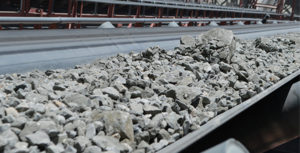Backlogs keep Martin Marietta moving in second quarter 2020
Martin Marietta concluded the first half of 2020 with the highest profitability in company history, although the company recognizes some long-term challenges are ahead as it continues to work through sizable backlogs.
“Customer backlogs are expected to support the company’s near-term shipment levels, though we currently anticipate an industry-wide decline in product demand over the next few quarters, particularly with the uncertainty of additional U.S. federal economic stimulus actions, as businesses and governments address budget shortfalls,” says Ward Nye, chairman and CEO of Martin Marietta. “Volume impacts from reduced demand will likely be temporary, gradual and varied by end use and geography.”
Martin Marietta brought in a gross profit of $380.5 million in the second quarter this year versus a second-quarter 2019 gross profit of $356.9 million. The company’s total revenues ($1.27 billion) were down just a hair compared with the same period of 2019 ($1.279 billion).
The company was also more profitable in this year’s second quarter within its aggregate business, achieving a gross profit of $268 million. Revenues within the company’s aggregate business ($754.9 million) were down slightly compared with the second quarter of 2019 ($757.8 million), though.
According to Martin Marietta, product demand trends remained strong in key Martin Marietta geographies, most notably in north Texas, Colorado and Indiana, as well as Georgia and Florida.
Aggregate shipments and pricing

Pricing was a positive story for Martin Marietta in the second quarter, with a 3.3 percent increase. Photo: P&Q Staff
While Martin Marietta’s second-quarter aggregate shipments were down 3.7 percent, pricing was up 3.3 percent.
“We remain confident that our favorable pricing trends will continue, aided in part by the continued success of our locally-driven pricing strategy,” Nye says. “We expect our full-year 2020 aggregates pricing to increase 3 percent to 4 percent, slightly below our pre-COVID-19 forecast, largely due to year-over-year geographic and product mix fluctuations.”
Martin Marietta’s Mid-America Group shipments decreased 7.2 percent, driven by near-record rainfall across much of its footprint and anticipated lower infrastructure shipments in portions of North Carolina. Pricing growth was limited in the group to 2.3 percent, the company says.
Shipments for the Southeast Group increased 3 percent, Martin Marietta says, as the Florida Department of Transportation accelerated certain transportation projects to leverage construction efficiencies driven by lower vehicle traffic during shelter-in-place orders. Also, Martin Marietta experienced continued strength in warehouse, data center and distribution facility construction. Weather-impacted construction delays partially offset these favorable trends, the company adds.
West Group shipments at Martin Marietta decreased 1 percent, with double-digit growth in north Texas and Colorado offset by the completion of certain Gulf Coast liquefied natural gas (LNG) projects and reduced energy-sector shipments. Pricing improved 5.5 percent, reflecting favorable product mix.
“In the medium- and long-term, we remain confident that the underlying demand drivers and fundamental strength of our top 10 states position the company to outperform through typical economic cycles,” Nye says.
Agg shipments by market
Additionally, Martin Marietta provided a breakdown of its aggregate shipments by market.
Shipments to the infrastructure market increased modestly in the second quarter, the company says, with Martin Marietta benefiting from large transportation projects in Texas, Colorado and Florida, as most state Departments of Transportation (DOT) continued to advance transportation projects.
Still, consistent with expectations prior to the pandemic, North Carolina’s DOT temporarily suspended awards for certain transportation projects in response to funding issues specific to weather-related disaster spending and Map Act settlements.
The infrastructure market accounted for 38 percent of Martin Marietta’s second-quarter aggregate shipments, which is below the company’s most recent 10-year annual average of 45 percent.
Aggregate shipments to the nonresidential market, meanwhile, declined following double-digit growth in commercial and heavy industrial construction activity in the prior-year quarter. Precipitation and temporary project delays hindered otherwise robust distribution center, warehouse and data center construction activity, Martin Marietta says.
The company also experienced reduced energy-related shipments due to the completion of certain windfarm and Gulf Coast LNG projects, as well as lower overall demand to the shale sector.
The nonresidential market represented 32 percent of second-quarter aggregate shipments, the company adds.
Lastly, aggregate shipments to the residential market increased, with growth throughout Texas, as well as in Charlotte and Denver. Following a brief pandemic-related pause in activity by national homebuilders, housing construction returned to pre-coronavirus levels, reflective of pent-up demand, low available inventories and favorable interest rates.
The residential market accounted for 24 percent of second-quarter aggregate shipments, Martin Marietta says.
The ChemRock/rail market accounted for the remaining 6 percent of Martin Marietta’s second-quarter aggregate shipments. Volumes to this end use were driven by improved ballast shipments to the Class I western railroads.










